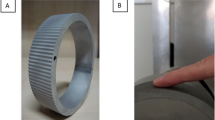Abstract
One of the main challenges facing the blind and visually impaired is independent mobility without being obtrusive to their environment. We developed a tactile low-cost finger-size sensory substitution device, the EyeCane, to aid the Blind in obstacle identification and avoidance in an unobtrusive manner. A simplified version of the EyeCane was tested on 6 sighted blindfolded participants who were naïve to the device. After a short (2–3 min) training period they were asked to identify and avoid knee-to-waist-high (Side) and sidewalk-height (Floor) obstacles using the EyeCane. Avoidance included walking around or stepping over the obstacles. We show that in the fifth trial, participants correctly identified 87 ± 13.6 % (mean ± SD) and correctly avoided 63 ± 15 % of the side obstacles compared to 14 % in the control condition (p < 4E-10 and p < 1.1E-05 respectively). For Floor obstacles, participants correctly identified 79 ± 18.8 % and correctly avoided 41 ± %37.6 compared to the control’s 10 % (p < 0.002 and p < 0.06 respectively).
Galit Buchs and Shachar Maidenbaum: equal contribution.
Access this chapter
Tax calculation will be finalised at checkout
Purchases are for personal use only
Similar content being viewed by others
References
Christy, B., Nirmalan, P.K.: Acceptance of the long cane by persons who are blind in south india. J. Vis. Impair. Blind. 100(2), 115–119 (2006)
Gold, D., Simson, H.: identifying the needs of people in canada who are blind or visually impaired preliminary results of a nation widestudy. Int. Congr. Ser. 1282, 139–142 (2005)
Russell, J.N., Hendershot, G.E., LeClere, F., Howie, L.J., Adler, M.: Trends and differential use of assistive technology devices: United States, 1994. Adv. Data 292, 1–9 (1997)
La Graw, S.: The use of sonic pathfinder as a secondary mobility aid for travel in buisness environments: a single- subject design. J. Rehabil. Res. Dev. 36(4), 333–340 (1999)
Penrod, W., Corbett, M.D., Blasch, B.: A master trainer class for professionals in teaching the ultracane electronic travel device. J. Vis. Impair. Blind. 99(11), 696–706 (2005)
Dakopoulos, D., Bourbakis, N.G.: Wearable obstacle avoidance electronic travel aids for blind: A survey. IEEE Trans. 40(1), 25–35 (2010)
Roentgen, U.R., Gelderblom, G.J., Soede, M., De Witte, L.P.: Inventory of electronic mobility aids for persons with visual impairments: A literature review. J. Vis. Impair. Blind. 102(11), 702–724 (2008)
Maidenbaum, S., Levy-Tzedek, S., Chebat, D.-R., Amedi, A.: Increasing accessibility to the blind of virtual environments, using a virtual mobility aid based on the ‘EyeCane’: feasibility study. PLoS ONE 8(8), e72555 (2013)
Innet, S., Ritnoom, N.: An application of infrared sensors for electronic white stick. In: International Symposium on Intelligent Signal Processing and Communication Systems, pp. 1–4 (2009)
Rodgers, M.D., Emerson, R.W.: Materials testing in long cane design: sensitivity, fiexibility, and transmission of vibration. J. Vis. Impair. Blind. 99(11), 696–706 (2005)
Koutsoklenis, A., Papadopoulos, K.: Haptic cues used for outdoor wayfinding by individuals. J. Vis. Impair. Blind. 108(1), 43–53 (2014)
Lenay, C., Gapenne, O., Hanneton, S., Marque, C., Genouell, C.: Sensory substitution: Limits and perspectives. In: Hatwell, Y. (ed.) Touching for Knowing, pp. 275–292. John Benjamins, Paris (2003)
Auvray, M., Lenay, C., Stewart, J.: Perceptual interactions in a minimalist virtual environment. New Ideas Psychol. 27(1), 32–47 (2009)
Horev, G., Saig, A., Knutsen, P.M., Pietr, M., Yu, C., Ahissar, E.: Motor-sensory convergence in object localization: a comparative study in rats and humans. Philos. Trans. R. Soc. Lond. B Biol. Sci. 366(1581), 3070–3076 (2011)
Amedi, A., Hanassy, S.: Infra Red based devices for guiding blind and visually impaired persons. WO Patent 2,012,090,114 (2012)
Chebat, D.-R., Schneider, F.C., Kupers, R., Ptito, M.: Navigation with a sensory substitution device in congenitally blind individuals. NeuroReport 22(7), 342–347 (2011)
Acknowledgements
We would like to thank Shlomi Hannasy for help in developing the EyeCane and in running the experiments. This work was supported by a European Research Council grant to AA (grant number 310809); The Charitable Gatsby Foundation; The James S. McDonnell Foundation scholar award (to AA; grant number 220020284); The Israel Science Foundation (grant number ISF 1684/08).
Author information
Authors and Affiliations
Corresponding author
Editor information
Editors and Affiliations
Rights and permissions
Copyright information
© 2014 Springer-Verlag Berlin Heidelberg
About this paper
Cite this paper
Buchs, G., Maidenbaum, S., Amedi, A. (2014). Obstacle Identification and Avoidance Using the ‘EyeCane’: a Tactile Sensory Substitution Device for Blind Individuals. In: Auvray, M., Duriez, C. (eds) Haptics: Neuroscience, Devices, Modeling, and Applications. EuroHaptics 2014. Lecture Notes in Computer Science(), vol 8619. Springer, Berlin, Heidelberg. https://doi.org/10.1007/978-3-662-44196-1_13
Download citation
DOI: https://doi.org/10.1007/978-3-662-44196-1_13
Published:
Publisher Name: Springer, Berlin, Heidelberg
Print ISBN: 978-3-662-44195-4
Online ISBN: 978-3-662-44196-1
eBook Packages: Computer ScienceComputer Science (R0)




